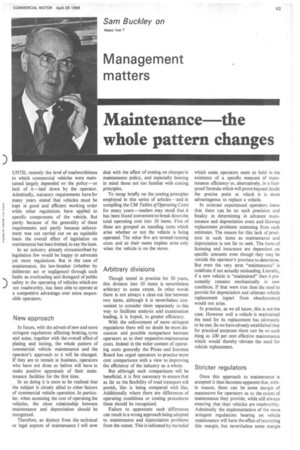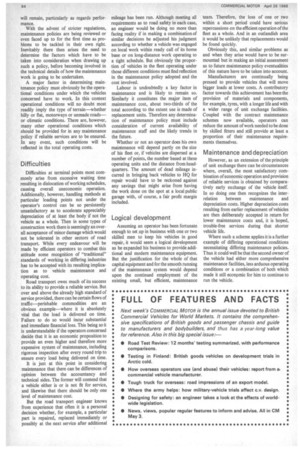Maintenance the whole pattern changes
Page 65

Page 66

If you've noticed an error in this article please click here to report it so we can fix it.
UNTIL recently the level of roadworthiness to which commercial vehicles were maintained largely depended on the policy—or lack of it—laid down by the operator. Admittedly, statutory requirements have for many years stated that vehicles must be kept in good and efficient working order while other regulations have applied to specific components of the vehicle. But partly because of the generality of these requirements and partly because enforcement was not carried out on an equitable basis the overall effect of legislation on maintenance has been limited, to say the least.
In an industry already circumscribed by legislation few would be happy to advocate yet more regulations. But in the case of maintenance, the law-breaker (whether by deliberate act or negligence) through such faults as overloading and disregard of public safety in the operating of vehicles which are not roadworthy, has been able to operate at a competitive advantage over mare responsible operators.
New approach
In future, with the advent of new and more stringent regulations affecting braking, tyres and noise, together with the overall effect of plating and testing, the whole pattern of commercial vehicle maintenance and the operator's approach to it will be changed. If they are to remain in business, operators who have not done so before will have to make positive appraisals of their maintenance facilities for the first time.
In so doing it is soon to be realized that the subject is closely allied to other factors of commercial vehicle operation. In particular, when assessing the cost of operating the vehicles, the close relationship between maintenance and depreciation should be recognized.
Therefore, as distinct from the technical or legal aspects of maintenance I will now deal with the effect of costing on changes in maintenance policy, and especially bearing in mind those not too familiar with costing principles.
To recap briefly on the costing principles employed in this series of articles—and in compiling the CM Tables of Operating Costs for many years—readers may recall that it has been found convenient to break down the total operating cost into 10 items. Five of these are grouped as standing costs which arise whether or not the vehicle is being operated. The other five are termed running costs and as their name implies arise only when the vehicle is on the move.
Arbitrary divisions
Though tested in practice for 50 years, this division into 10 items is nevertheless arbitrary to some extent. In other words there is not always a clear-cut line between two items, although it is nevertheless convenient to consider them separately in this way to facilitate analysis and examination leading, it is hoped, to greater efficiency.
With the enforcement of more stringent regulations there will no doubt be more discussion and possible comparison between operators as to their respective maintenance costs. Indeed in the wider context of operating costs generally the Prices and Incomes Board has urged operators to practise more cost comparisons with a view to improving the efficiency of the industry as a whole.
But although such comparisons will be beneficial, it is first necessary to ensure that as far as the flexibility of road transport will permit, like is being compared with like. Additionally where there are differences of operating conditions or costing procedures these should be recognized.
Failure to appreciate such differences can result in a wrong approach being adopted to maintenance and depreciation problems from the outset. This is indicated by the belief which some operators seem to hold in the existence of a specific measure of maintenance efficiency or, alternatively, in a foolproof formula which will prove beyond doubt the precise point at which it is most advantageous to replace a vehicle.
In contrast experienced operators know that there can be no such precision and finality in determining in advance maintenance and depreciation costs and likewise replacement problems stemming from such estimates. The reason for this lack of precision in such items as maintenance and depreciation is not far to seek. The items of licensing and insurance are dependent on specific amounts even though they may be outside the operator's province to determine. But even the very term "maintenance" is indefinite if not actually misleading. Literally, if a new vehicle is "maintained" then it presumably remains mechanically in new condition. If that were true then the need to provide for depreciation and ultimate vehicle replacement (apart from obsolescence) would not arise.
In practice, as we all know, this is not the case. However well a vehicle is maintained the need for its replacement has ultimately to he met. So we have already established that for practical purposes there can be no such thing as 100 per cent effective maintenance which would thereby 'obviate the need for vehicle replacement.
Stricter regulators
Once this approach to maintenance is accepted it then becomes apparent that, within reason, there can be some margin of manoeuvre for operators as to the extent of maintenance they provide, while still always ensuring that their vehicles are roadworthy. Admittedly the implementation of the more stringent regulations bearing on vehicle maintenance will have the effect of restricting this margin, but nevertheless some margin will remain, particularly as regards performance.
With the advent of stricter regulations, maintenance policies are being reviewed or even faced up to for the first time as problems to be tackled in their own right. Inevitably there then arises the need to determine the factors which have to be taken into consideration when drawing up such a policy, before becoming involved in the technical details of how the maintenance work is going to be undertaken.
A major factor in determining maintenance policy must obviously be the operational conditions under which the vehicles concerned have to work. In this context operational conditions will no doubt most readily imply the type of terrain—whether hilly or flat, motorways or unmade roads— or climatic conditions. There are, however, many other operational conditions which should be provided for in any maintenance policy if reliable services are to be ensured. In any event, such conditions will be reflected in the total operating costs.
Difficulties Difficulties at terminal points most commonly arise from excessive waiting time resulting in dislocation of working schedules, causing overall uneconomic operation. Additionally, however, handling methods at particular loading points not under the operator's control can be so persistently unsatisfactory as to accelerate appreciably depreciation of at least the body if not the vehicle as a whole. Then in some types of construction work there is seemingly an overall acceptance of minor damage which would not be tolerated in other sectors of road transport. While every endeavour will be made by efficient operators to combat this attitude some recognition of "traditional" standards of working in differing industries has to be accepted with its resulting implication as to vehicle maintenance and operating cost.
Road transport owes much of its success to its ability to provide a reliable service. But over and above the already high standard of service provided, there can be certain flows of traffic—perishable commodities are an obvious example—where it is absolutely vital that the load is delivered on time. Failure to do so would incur substantial and immediate financial loss. This being so it is understandable if the operators concerned decide that it is an economic proposition to provide an even higher and therefore more expensive system of maintenance, including rigorous inspection after every round trip to ensure every load being delivered on time.
It is just at this point in considering maintenance that there can be differences of opinion between the accountancy and technical sides. The former will contend that a vehicle either is or is not fit for service, and likewise that there should be only one level of maintenance cost.
But the road transport engineer knows from experience that often it is a personal decision whether, for example, a particular part is repaired, replaced immediately or possibly at the next service after additional mileage has been run. Although meeting all requirements as to road safety in each case, an engineer would be doing no more than facing reality if in making a combination of similar decisions he adjusted his judgment according to whether a vehicle was engaged on local work within ready call of its home base or on long-distance work operating to a tight schedule. But obviously the proportion of vehicles in the fleet operating under those different conditions must find reflection in the maintenance policy adopted and the cost involved.
Labour is undoubtedly a key factor in maintenance and is likely to remain so. Similarly it constitutes the major item of maintenance cost, about two-thirds of the total according to the extent use is made of replacement units. Therefore any determination of maintenance policy must include consideration of current availability of maintenance staff and the likely trends in the future. , Whether or not an operator does his own maintenance will depend partly on the size of his fleet or, if vehicles are dispersed at a number of points, the number based at these operating units and the distance from headquarters. The amount of dead mileage incurred in bringing back vehicles to HQ for repair would have to be reckoned against any savings that might arise from having the work done on the spot at a local public garage with, of course, a fair profit margin included.
Logical development Assuming an operator has been fortunate enough to set up in business with one or two skilled men to keep his vehicles in good repair, it would seem a logical development as he expanded his business to provide additional and modern maintenance equipment. But the justification for the whole of that capital equipment and for the smooth running of the maintenance system would depend upon the continued employment of the existing small, but efficient, maintenance team. Therefore, the loss of one or two within a short period could have serious repercussions on the efficient operation of the fleet as a whole. And in an outlandish area it would be unlikely that replacements would be found quickly.
Obviously this, and similar problems as and when they arise would have to be surmounted but in making an initial assessment as to future maintenance policy eventualities of this nature have to be taken into account.
Manufacturers are continually being pressed to provide vehicles that will move bigger loads at lower costs. A contributory factor towards this achievement has been the provision of materials and components, for example, tyres, with a longer life and with a wider range of unit exchange facilities. Coupled with the contract maintenance schemes now available, operators can reduce the amount of work needed to be done by skilled fitters and still provide at least a proportion of their maintenance requirements themselves.
Maintenance and depreciation However, as an extension of the principle of unit exchange there can be circumstances where, overall, the most satisfactory combination of economic operation and provision of reliable services is obtained by comparatively early exchange of the vehicle itself. In so doing one then recognizes the interrelation between maintenance and depreciation costs. Higher depreciation costs resulting from earlier replacement of vehicles are then deliberately accepted in return for lower maintenance costs and, it is hoped, trouble-free services during that shorter vehicle life.
Where such a scheme applies it is a further example of differing operational conditions necessitating differing maintenance policies. Thus it could well be that the second owner of the vehicle had either more comprehensive maintenance facilities, less arduous operating conditions or a combination of both which made it still economic for him to continue to run the vehicle.




















































































































